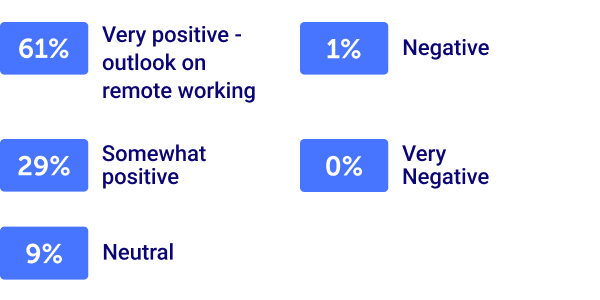Upskilling and reskilling teams for hybrid and remote collaboration
A Definitive Guide

The professional world is in a very different place from where it was at the beginning of 2020. The impact of the global pandemic meant businesses across the globe had to adapt and rethink the way they approached their day-to-day operations.
Arguably, the biggest change came in the form of wide-scale remote working. With so many of us unable to leave our homes, companies were left with no choice but to facilitate makeshift offices in lounges, dining rooms, kitchens, and even sheds.
Three years on, some businesses have found that employing remote or hybrid workers has a positive impact. Providing versatility and efficiency, it’s little wonder this new-age approach to office life (or lack thereof) has become popular.
But while a remote policy brings a host of benefits, it also provides its own set of challenges. Chief among them is ensuring your team continues to get the dedicated training and upskilling they need to thrive.
In this guide, we’ll look at just that. Whether your team is fully remote or works in a hybrid capacity, this resource will provide the tools required to help guide your workforce towards their full potential—no matter where their home base is.
Chapter 1 - An introduction to hybrid and remote working
We all understand that terms like ‘hybrid’ and ‘remote’ refer to an employee who primarily works from a location away from a business’ hub of operations. Let’s explore the subtle differences between these two working arrangements, as well as the benefits for an employer of hiring someone in this capacity.

What is hybrid working?
If someone is referred to as a hybrid worker, it means they can work from a number of places—including their employer’s office. This type of employee is able to flexibly shift between locations. This is usually dependent on what is best for their specific working needs on a day-to-day basis, although businesses may set requirements for a number of days in the office.
Owing to the relative versatility of this type of work model, there is a variety of options a business offering hybrid working can use:
At-will and remote-first
This option gives people the chance to stay at home as frequently as they’d like, with free will to come to the office whenever they see fit.
Split-week
This model would see certain days assigned to the office, and others allowing people to stay home or come in.
Week-by-week
As the name suggests, this would see a team shift between an at-home and in-person model of work on a week-to-week basis.
Office-first
Here, employees are encouraged to come to the office as a first choice, with work-from-home options available on request.
Designated teams
Some teams might need to be present in an office, while others can work from anywhere. This model makes logical sense, but can be divisive.
Remember, different businesses will use varying terms for these types of policies. Make sure you understand what your company operates using.
Discuss in detail the model you follow with your team first. It’s important everyone understands what is, or isn’t allowed as part of a hybrid role.

What is remote working?
In the digital age, a lot of jobs can be done from practically any location. Remote working allows a person to work from the place which best suits their needs—typically this is at home, but remote working gives employees the choice of where they work. There are lots of reasons why someone might find it easier to work from somewhere other than an office.
Good examples of why someone might want to work away from a centralised hub include:
- Balancing time with caring for young children
- Removing themselves from a distracting environment
- Providing a necessary change of scenery to remain productive
- Alleviating the need to commute long distances for work
Some people like the structure and social nature of office life. However, as more employers are realising, this type of working lifestyle isn’t the first choice of everyone.
Naturally, this kind of workplace policy relies heavily on trusting your employees to do the right thing when you’re not around. While this is a big step for most companies, it’s something that a workforce will really appreciate.

Hybrid and remote working statistics
Would it shock you to learn that as many as 96.7% of people who’ve had a taste of the remote working lifestyle want to continue operating that way forever? Whether in a permanent or hybrid capacity, there’s a clear desire from most to spend more time doing their work from the comfort of their own home.
Despite relatively loosened COVID-19 restrictions, as many as 38% of people surveyed in a government poll were found to be working from home in some capacity during an average work week. This is a staggering jump from where we were in pre-pandemic days, when just 4.7% worked from home (up from 1.5% back in 1981).

Where are people working?
When it came to where people spent the most time working, a study (28%) came out as the top location. Some of the other popular areas of the home included:

How do people feel about remote working?
The main message remote workers want to spread is that they ultimately feel very positive about it. A study by Buffer reported as many as 90% of those asked had good things to say about remote or hybrid work:

What are the benefits of remote working for employees?
When it came to the biggest benefits for employees, there was a fairly even spread of answers. Buffer again found employees benefited from:

Productivity is a concern for some employers toying with the idea of remote work policies. Encouragingly, this wasn’t an area which a took a hit, with reports showing:
Perhaps most importantly, over a quarter (29.8%) of employees said they had actually managed to get more done while working from home, compared to the traditional office environment.

The benefits of hybrid and remote working
While a brand new way of working might have been unthinkable a decade ago, the recent adoption of remote and hybrid policies has opened the eyes of even the most doubtful. For those who still aren’t sure whether this is a good approach, here are a handful of benefits for employers:
Employee satisfaction
Giving your staff the power to work where (and sometimes even when) they like can help them stay motivated. This autonomous approach to the workplace shows that you trust them. In turn, you’ll build a mutual appreciation that leaves them feeling connected and determined. In short, the more freedom someone has, the happier they tend to be.
Heightened productivity
Giving a team member the flexibility to work from either your centralised office, or where they feel most comfortable, sets them up to maximise their work output. People tend to perform best on their own terms. With a hybrid or remote model, you place the power to do that in the hands of your employees.
Improved mental health
A survey by Forbes found as many as 90% of people think having a good work-life balance is an important part of their job. By offering them the chance to balance their life in a way which suits their needs, an employer gives them a platform to feel happy and fulfilled (both professionally and socially).
Easier collaboration on projects
While moving away from one location might mean you’re not able to collaborate face-to-face, the power of the internet means you’ll be able to talk to anyone, anywhere in the world, at any time. All it takes is a few seconds to jump on a call and sink your teeth into a project.
Chapter 2 - Common issues with remote and hybrid working and how to solve them
We’ve looked at all the positive aspects of introducing a hybrid or remote working policy. But that doesn’t mean it’s all sunshine and roses. There are definitely still hurdles that need to be traversed. Let’s take a closer look at some of them, as well as the solutions to each.

Issues and solutions of remote working
Tracking tasks and productivity
It could be that you let your workforce use autonomous planning to stay on top of their workload. While this is great in theory, it makes it tougher to understand what is or isn’t getting delivered on time. It’s also harder to spot when someone might be performing at a slower rate than what you know they’re capable of.
This is where a tool like Atlassian can be a lifesaver. It helps to set clearly defined deadlines for tasks, as well as assigning them to specific team members. This data makes it easy to find out what workloads and output look like on a person-by-person basis.
Understanding and use of video calls
While it might come as second nature for most of us, some people are less confident using video tools such as Zoom, Slack, and other contemporary technology. This can make interacting with colleagues challenging.
Providing people with specific training is a great way to ensure they’re literate enough with technological software to effectively communicate.
Different time zones
Remote working means you might have the opportunity to take on team members from all around the world. While that’s ultimately a good thing, it does mean there could be delays in response if two employees are located at opposite ends of the globe. For example, the time in New York is a whopping 13 hours behind Tokyo.
It’s important to set soft guidelines and expectations for your team. While nobody should be expected to work late into the night, or get up ridiculously early, each employee needs to be able to manage their time in accordance with the rest of their colleagues. Ask them to provide a rough schedule of when they expect to work, as well as scheduling meetings for a time that works for everyone.
Building trust with new employees
If someone is onboarded remotely, it might be hard to instantly feel confident that they’re performing to the levels you expect of them. It’s only natural that someone you might never have met face-to-face doesn’t instantly warrant your full trust. Don’t feel guilty, this is a natural human response.
It can be really challenging to build a genuine, trusting relationship with a person you’ve never met. Start by getting to know them on a personal level, and set up regular catch-ups to check in on them. These don’t have to assess their performance, but rather to see if there’s anything you can do to support them. Helping them with a career plan and setting shared goals are also a great way to measure their progress without becoming a micromanager. A soft skills training course could benefit any leader who finds themselves in this position.
Separating work from home
If you work where you live, it might be hard to switch off your professional brain when the day is over. This can lead to someone feeling trapped, stressed, and even resentful of their home environment. This may be particularly challenging if you’re someone who sits behind a desk all day.
Try to encourage your employees to have a dedicated area of the home to work. This should ideally be somewhere where they aren’t likely to spend the rest of your day. For example, bedrooms or living rooms aren’t good options. If they’re fortunate enough, someone might even have a spare room which can become a dedicated office. Also, encourage your team to take regular walks outside if they start to feel cooped up. A change of scenery provides a welcome mental break.
Issues and solutions of hybrid working
A lack of defined policies
If you offer a part-office, part-home balance, employees might be confused about how often they are or aren’t expected to show up. There may even be inadvertent pressure to spend more time in the office, if they feel like it could benefit them in some way to be more present.
The easy solution here is to make it crystal clear what you do or don’t expect of your team. Earlier we looked at the different types of hybrid work policies:
- t-will and remote-first
- Split-week
- Week-by-week
- Office-first
- Designated teams
Make it clear exactly which type you are operating, and have a set of guidelines for what the best course of action is for your team.
Lack of buy-in from everyone
It might surprise you, but not everyone wants to give up their office time. Some people prefer the communal atmosphere of this kind of working environment, over the relative solitude of their home. That might result in some people refusing to fully embrace this type of policy.
The best thing to do is sit down with any disgruntled parties and come to a resolution. Hear them out, learn what their gripes are, and do your best to overcome them. It’s important to nip this in the bud before it trickles down through the company.
Building relationships online
We’ve already discussed how it might be hard to nurture trust when you’re primarily digitally-based. The same is true when it comes to forming strong human connections. This is especially relevant to team members you’ve never had the chance to meet in person.
Ensure that you host regular virtual events (ideally one a month) to help your team bond. Another clever trick is to hold a virtual catch-up once a week over lunch, or make socialising a part of any weekly company-wide update calls.
Chapter 3 - Upskilling and reskilling your remote or hybrid team
Remote working doesn’t mean throwing your team in at the deep end and hoping they swim. There’s still a duty of care for you to ensure they get the training and support they need to continue growing and developing as professionals. Let’s take a look at the importance of upskilling, how to successfully train your team, and the mistakes to avoid.

The importance of upskilling
As many as 52% of people consider leaving their job every month as a result of a lack of clear and obvious progression.
The numbers are a little eye-opening, but the good news is that adopting a policy of training and improvement is enough to quickly dispel those notions. The LinkedIn Workplace Report found a staggering 94% of people would stay at a company longer if learning and development was put at the forefront of their working experience.
Gaps usually develop when technological and market trends are not addressed properly by an organisation. Research by McKinsey found that as many as 43% businesses are already experiencing some sort of skill gap because of these factors.
The research also highlighted when organisations expect their next big skill gaps to emerge:

As many as 30% of respondents say they expect at least a quarter of all jobs to be disrupted in some way as a result of skill gaps emerging. The failure to properly address emerging gaps as a result of working from home has been felt most in regards to cybersecurity.
CIO Dive found that 39% of businesses they questioned said their work from home policy had led to a gap in this field. Other areas of concern were:

It’s also clear that businesses need to actively encourage their workforce to explore upskilling opportunities. 35% of workers asked by Talent LMS reported they hadn’t ever sought out training on their own.
For those who did, their concentration was split across a number of areas:
Worryingly, despite an enormous 97% of workers saying they saw upskilling as something they’d like to pursue, the same sample size believed just 5% of their employers saw this as an essential part of their job.

The benefits of upskilling your workforce
Taking the time, effort, and, in some cases money, to upskill or train an employee can be a stretch for businesses—particularly SMEs with a remote working policy. Despite that, it’s an important part of how any business grows. For any leaders who aren’t totally sold on the need to upskill their team, it’s important to keep these factors in mind:

Higher standards of work
Kicking off with arguably the most important point of all; improving the core skills of your team will result in a higher quality of work across the business. For a company to thrive, they need highly-skilled people in every area or department.

Filling gaps in your company
Employers often turn to hiring as the first port of call for filling skill gaps. This is sometimes a viable route for specific areas of expertise, but it isn't always the solution. Look at your current workforce and decide whether upskilling would make more sense than bringing in a totally new worker.

Employee retention increases
Being given the opportunity to grow and learn is at the forefront of a lot of people’s career goals. It’s rare you’ll find someone who joins a company and wants to remain in the position they’re in. Giving them the opportunity to progress professionally shows you’re invested in them as a team member and a person, not just a number.

Customer or client retention
It stands to reason that a highly skilled workforce will increase your chances of retaining customers or clients. The better the service you provide, the higher the likelihood that people will turn to your organisation again in the future for repeat business.
How to upskill your remote or hybrid team
If you’ve decided upskilling is the way to go for your business, it’s time to look into the best ways to execute your vision. While there’s no one-size-fits-all approach to learning, there are tried-and-tested ways to ensure your team gets the most out of a training session. Here are some options to keep in mind:

Provide blended learning experiences
Offering a healthy mix of experiences gives your team the chance to trial different types of learning. You’ll want to combine synchronous and asynchronous sessions. The former is typically training done as a live collaborative group session, while the latter is individual learning that can be done at an employee’s own pace.

Peer coaching and mentoring
In an ideal world, you won’t have to turn to an official program or external expert to help skill your team up. If you have existing colleagues who can lend support or guidance, assign them as temporary mentors or coaches. They can educate, provide guidance and reassurance, and also check to see how progression is going.

Personal development plans
Having a clear structure in place for someone's progression helps to acutely hone in on a specific skill. You can set benchmarks and goals to hit along the way, with a larger end-goal in mind. This allows the individual to regularly check where they are, and makes it quickly apparent if there are additional steps they need to take to meet their targets.

Job rotation days
Some people learn best by immersing themselves in a role. This innovative approach sees people from different departments temporarily shadowing their colleagues, as they gain a better understanding of the skills they need to master. Often, this strategy is best executed by letting people of a similar seniority learn from one another. This gives a more rounded perspective on what they do and don’t need to improve.

Create bitesize training materials
Large training manuals are difficult to digest. Creating small training modules lets someone absorb information at a pace that works for them. You can also provide visual learning resources, like infographics, charts, graphs, and roadmaps.

Offer incentives for hesitant employees
Between high workloads and the piling up of calls, some team members can struggle to find the time to train. They’ll see getting their work done on time, to a good standard, as the priority. Incentivise them by offering training rewards, such as vouchers, gift cards, and even bonuses. You can also make it clear that training can be done during work hours.
Upskilling managers and team leads
It’s not just regular team members who need to brush up on skills. From time to time, team leads, managers, and even directors all need to master something new—especially at a time when remote or hybrid working is becoming more normal.
Here are some important skills that the leaders of today and tomorrow need to learn, or get a refresher on:

Emotional intelligence
To effectively lead others, a person needs to have strong empathy, rationale, compassion, self awareness, motivation, and social skills. These are the framework of what makes a good manager tick. It’s vital that a leader understands and supports their team on an emotional level, as well as a professional one.

Adaptability and versatility
No matter what level of planning you invest in a project, there’s always a chance that unforeseen events could scupper plans. A team leader must adapt on the spot, as they respond to change that wasn’t factored into their original plans.

Strong communication skills
Managers need to communicate in a way that’s transparent, reassuring, nurturing, and educational. They might also need to have difficult chats at times, which means framing less positive news in a way that doesn’t demoralise their team.

Specifically tailor training
As more senior members of a team, it’s highly unlikely that a cookie-cutter approach to training will be very effective. This is especially true if you’re trying to hone in on remote leadership skills. Get in touch with your leads first, and learn what they think they need to work on, or are unsure about in a remote environment.

Blend formal and informal training
As existing leads may be busier than an average employee, it might be better to provide a mix of formal (modular) and informal (podcasts, books, or TED talks) training. In the remote age, this informal approach can be particularly useful. It gives leaders the chance to sit down and digest ways to manage teams at their own pace.

Focus on culture
Collaboration and a healthy team dynamic are both vital aspects of a remote or hybrid working policy. As such, any training of senior team members should ideally focus heavily around nurturing an inclusive company culture. Impart the value of supporting your team, and ensure they remain committed and loyal, even with a reduction in face-to-face interactions.
Mistakes to avoid when upskilling
Just as with any aspect of a business, you need to tread carefully when implementing an upskilling plan. Failure to execute this properly can lead to further issues down the line. Avoid falling into the following traps ahead of time with these helpful pointers :

Waiting for the skill gap to be obvious
If you’ve noticed an employee—or an area of your business—is missing the necessary skills to succeed, you’re already putting yourself on the back foot. While this position can be recovered from, it’s always best to pre-empt potential gaps, and ensure training is provided before it can have an impact.

Not personalising your training
Everyone learns differently. Finding pre-produced training programs might seem efficient, but there’s a chance they don’t meet the needs of every member of your team. Taking the time to sit down and create a progression or development plan with someone might take more effort in the short term, but will have a bigger impact further down the line.

Investing in the wrong skills
Do the areas you’re focusing on really need improving? Hybrid and remote challenges may be different to those you face in an office. Explore your options to give team members a variety of programs to choose from. They’ll know best what they do and don’t need to work on.

Thinking a skill has to be mastered
It’s understandable to think the only way to consider training a success is by your employee totally mastering what they were learning. This is especially true in a remote environment, where you don’t physically see them put their new abilities into action.
Helpful tools when upskilling

GoToTraining
GoToTraining is perfect if you’re looking to help educate your employees remotely. It provides a platform for someone in your organisation, or a skilled external expert, to record videos, present meetings, and have one-to-one chats with your team. You can also integrate YouTube and Vimeo links to add an interactive element.

Trello
Using Trello, you’ll be able to organise the entirety of the upskilling process. You can create boards that are ordered depending on someone’s training stage. The tool also lets you add comments and replies to each benchmark.

Slack
Serving as your core channel of communication, Slack allows team members to talk to each other via an instant messenger service from anywhere in the world. This means employees are always just quick text away from getting the answer they need, without the need to organise a call.

Atlassian
This software provides a centralised hub to create tasks or tickets, assign jobs, track progress, store learning resources, and generally manage and oversee a project from start to finish. This makes it simple to chart out and follow the progression of a development plan. It also makes it easy to spot where someone might be stalled or struggling.
Useful links
You should now have a better idea of remote upskilling, and how it can benefit your business. If you’d like to find out more about how to manage a remote workforce, check out these handy secondary sources.



